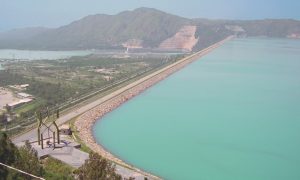Flood situation at Sindh’s barrages not alarming despite record rains, says official
Dawn, August 3rd, 2022
HYDERABAD: Like Guddu, Sukkur Barrage is also in a state of low flood while inflows at Guddu upstream are constantly increasing, according to officials.
Irrigation authorities have reduced water discharges for left bank canals in anticipation of another spell of monsoon rainfall in Sindh this week.
Low flood level persists at Guddu Barrage since 6pm on July 25 after which Sukkur Barrage attained low flood status at 6pm on July 27. Since then discharges at Guddu, Sukkur and Kotri barrages have been increasing.
On Aug 2, Guddu Barrage recorded a flow of 357,628 cusecs upstream and 329,326 cusecs downstream recorded at 6am. Sukkur Barrage recorded a flow of 294,810 cusecs upstream and 258,900 cusecs downstream while Kotri Barrage upstream flow stood at 174,237 cusecs upstream and 147,082 cusecs downstream.
Above-normal rainfall expected later this month likely to change the scenario
Kotri downstream discharges are seen only in flood season otherwise they either remain zero or inadequate as against the Water Apportionment Accord 1991.
Today (on Aug 2), the storage in Tarbela Dam stood at 1,532 feet – 18 feet short of its optimum level – while Mangla Dam storage stood at 1,155.8 feet. At 6pm, Guddu Barrage had a discharge of 361,095 cusecs upstream and 331,943 cusecs downstream; Sukkur had upstream flow of 294,810 cusecs and 258,900 downstream. Kotri Barrage upstream flows were recorded at 180,960 cusecs and 153,475 cusecs downstream.
Irsa official, Khalid Idris Rana said that rim stations were showing a reduction in flows in the river system. “Lately we had seen a flow of 550,000 cusecs which will drop to 250,000 cusecs in the river system soon,” he said. Referring to flows of Indus at Tarbela, he said they dropped from 270,000 cusecs at 6am to 241,000 cusecs at 6pm today. He further said that Chenab and Kabul rivers’ flows were also recording a decline.
“Storage will improve in Tarbela while Mangla will have a maximum storage of 1,170 feet,” he said.
However, he added, going by rainfall forecasts of Pakistan Meteorological Department (PMD), another spell would start soon and this would again trigger increased supplies into the river system. “PMD says that above-normal rainfall is expected in the system,” he pointed out. He said that provinces had sufficient water flows at their barrages and it would take around 15 days to utilise these flows completely.
Another official said lowest temperature of 18 degree centigrade in Skardu ensures supplies but if it drops to below this point then flows would reduce. Today, he said, the maximum temperature was recorded at 29.4 degree centigrade which was expected to rise to 30 degree centigrade. “Rainfall is also expected in upper catchment that may benefit flows in Mangla,” he said.
Situation not alarming
While flows in Indus have inundated parts of Sindh’s riverine area, the situation is not alarming. “Flows are sufficient and flood situation is not alarming,” said Sukkur Barrage official Aziz Soomro. He said that now water was being stored at Chashma while flows at Tarbela were showing a decline. “All right bank canals of Sukkur barrage are being supplied water. Month of July witnessed adequate flows and ongoing month of August will also be comfortable as far as flows are concerned,” he said.
Sukkur barrage’s left bank canals are now getting reduced flows. Rohri Canal superintending engineer Zaheer Memon said the canal was now getting discharges of 5,500 cusecs. “It remained closed with zero flows between July 22 and 28 during recent rainfall. But now flows are allowed in the canal,” he said.
Similarly, Nara canal is also getting 4,500 cusecs which, until recently, had been receiving 8,500 cusecs.
According to Nara Canal superintending engineer Mansoor Memon, the very flows are being used for filling Chotiyari reservoir. “The reservoir is filled through Ranto Canal,” he said, and noted that there was a forecast of heavy rainfall from Aug 5. “Command area of Nara Canal doesn’t have a proper drainage system. So, flows from the canal coupled with anticipated rainfall can aggravate situation in its command areas from drainage point of view,” he said. This was the reason that flows in Nara Canal had been reduced, he said.
Meanwhile, in view of massive flooding caused by the monsoon rains, Balochistan is only receiving flows from Khirthar Canal of Sukkur barrage while provincial irrigation authorities have stopped getting flows through Pat Feeder Canal of Guddu Barrage at RD-109. At Garang regulator of Khirthar Canal, the province is getting 1,530 cusecs. This is perhaps due to the fact that the areas fed by Khirthar Canal remained less-affected by flooding.







